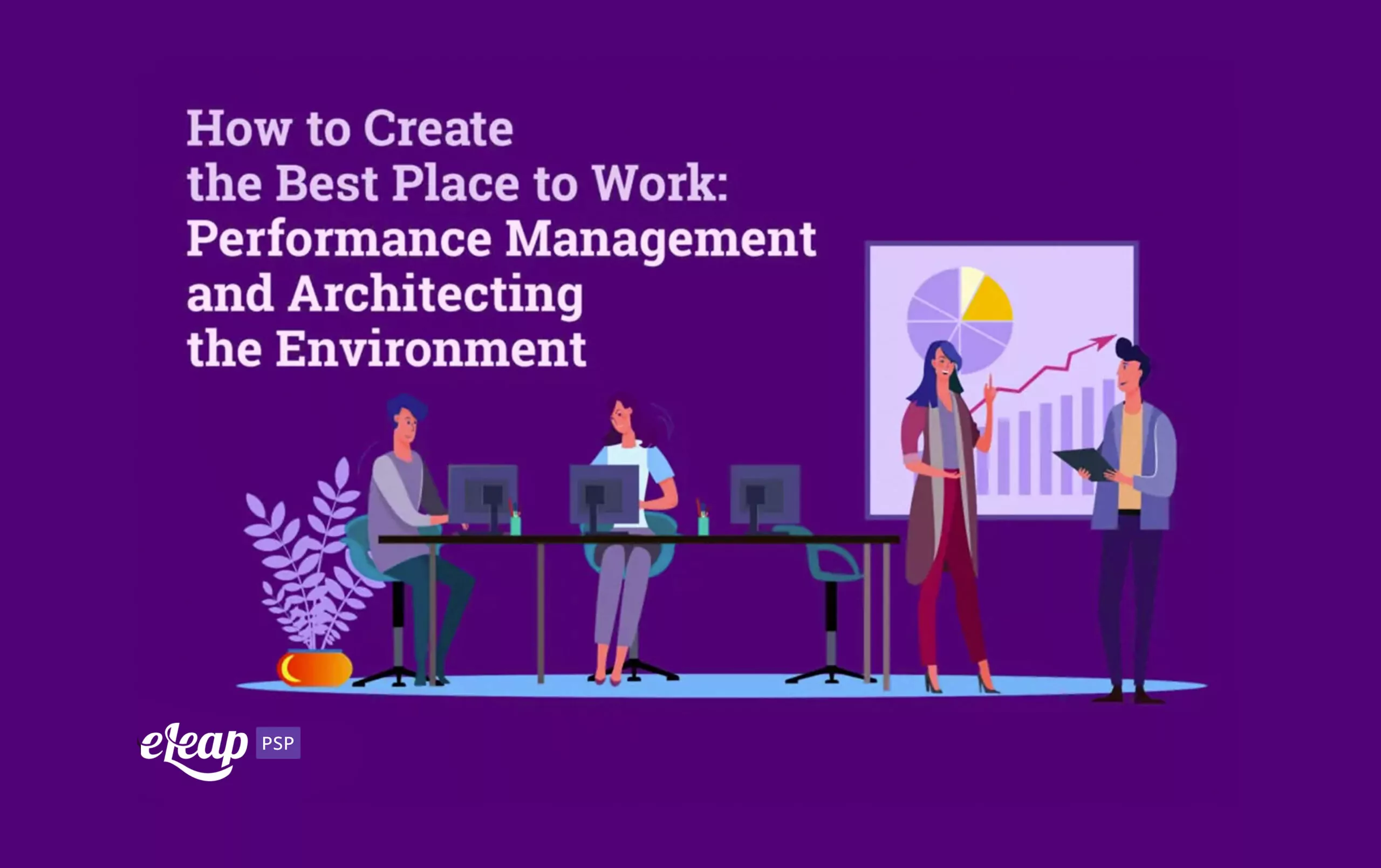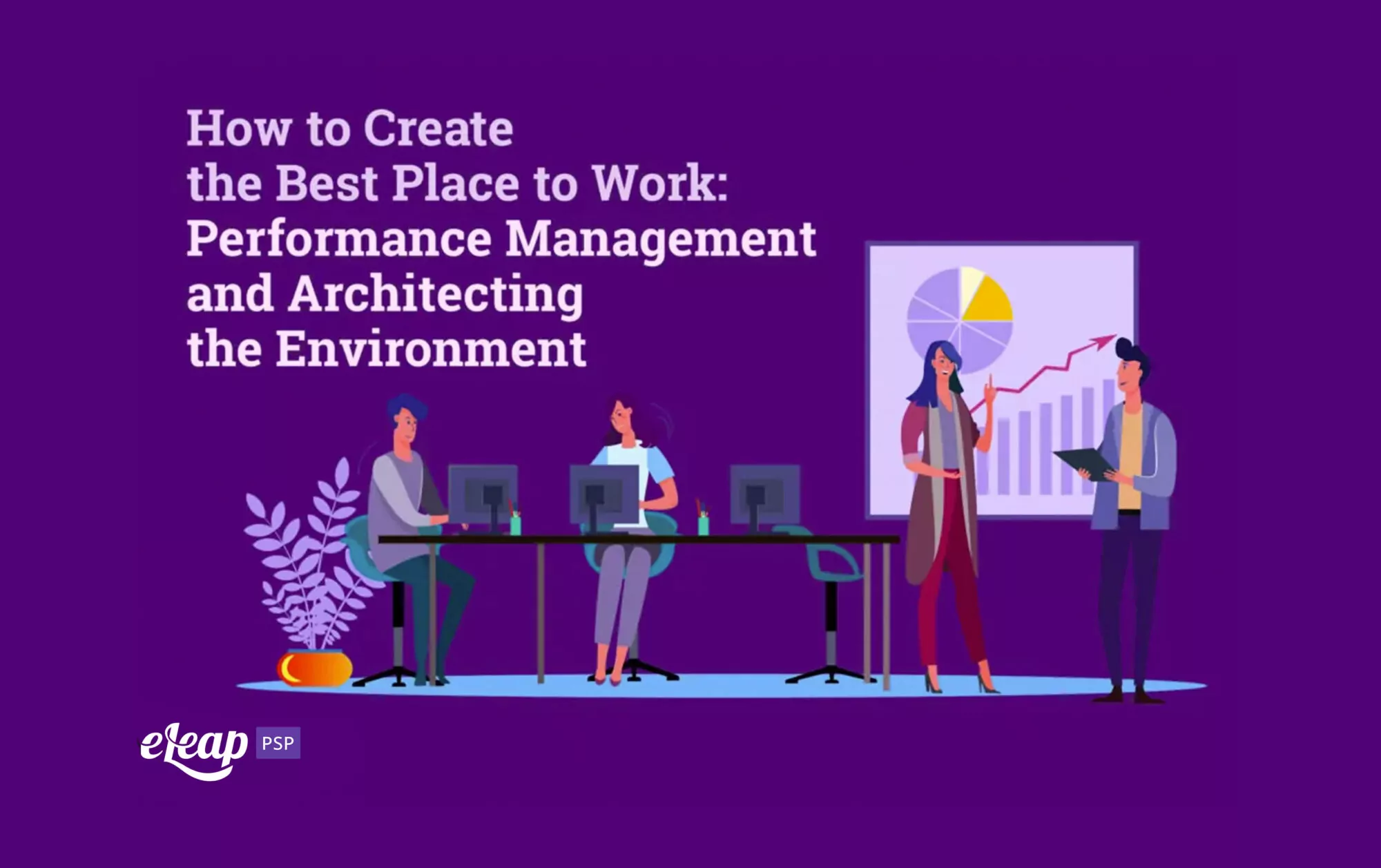How to Create the Best Place to Work: Performance Management and Architecting the Environment

When you think of performance management, you likely imagine annual performance reviews. Of course, you might be more forward-thinking, in which case you think about sit-down, one-on-one meetings held every quarter. However, what do you think about the workplace environment? Do you think about the role of enjoyment as one of the performance management techniques to use to increase employee performance? Explore how eLeaP’s Performance Management Platform can simplify evaluations, boost productivity, and drive measurable results.
Probably not, but you should. After all, if an employee hates the environment, they’re not going to give it their all, day in and day out. It’s up to management to create a culture where employees can thrive, be happy, and be committed to going above and beyond. What does it take to create a great place to work, though? We’ll explore what you need to know right here.

Weekly Check-Ins
To be clear, annual performance reviews are worthless. Their time has come and gone. Today, your organization needs to embrace a more agile model of performance management, something that’s able to deliver important information to team members now when they have the opportunity to act on constructive criticism. This is where check-ins enter the picture.
A check-in is a less formal version of the old performance review. It’s also done much more frequently. Of course, “frequently” can be pretty subjective.
Some organizations feel that quarterly check-ins are all you need. Others think that once per month is enough. The truth is that the more frequent the check-in, the better. We recommend weekly check-ins so that you can provide team members with immediate, actionable information that they can use right away.
Doing otherwise creates inevitable delays. And what’s the point of telling someone weeks after the fact that they did something wrong? It’s useless information.
Chances are good that there were numerous opportunities between the initial misstep and the time of the review or check-in when the employee could have put constructive criticism to work and improved their performance, but because you weren’t committed to delivering timely reviews, you failed them.
Check in regularly, weekly, if possible. Provide constructive criticism and support. Use this as an opportunity to help and build up, not to discipline and tear down. Use these performance management techniques to improve the outcomes you want for your organization.
Continuous Feedback
With frequent check-ins comes the opportunity to provide employees with continuous feedback. It’s a substitute for all the information that would normally be shared in an annual performance review but breaks it down into regular dialog between employees and managers.
However, don’t assume that this feedback is just feedback. It’s so much more than providing employees with a stream of critical observations. It’s designed to do more than help employees reach some imaginary performance mark at which they’re deemed worthy to see a monetary raise.
Rather than being focused on rankings or reprisals, it’s focused on creating better results and fostering a sense of community. It’s goal-oriented in that you’re providing feedback that leads to actionable steps and results in the achievement of performance and developmental objectives. Combine a focus on continuous feedback with regular check-ins, and you’ll see a change in your workplace culture, employee performance, and the levels of success you’re able to achieve.
Setting and Tracking Objectives
To be clear, changing the performance management paradigm does not mean that you don’t set objectives for employees to reach in terms of performance. What it means is that you need to set clear objectives and then use regular check-ins and continuous feedback to monitor and track performance toward them. What sort of objectives, though?
In an employee-centric organization (which is what you’re trying to build), you need to focus on employee strengths and weaknesses. However, you need to do this uncritically. What does this performance management technique mean, though?
For employee weaknesses, you need to set objectives in terms of how they can develop themselves. If an employee is struggling in a particular area, discuss how they can develop themselves. Provide them with tools and set objectives, then track their progress toward reaching those objectives. In this case, it would be gauging progress on improving in areas where they’re weak.
Objectives can also be set in terms of employee strengths. If an employee is strong at something, set objectives on using those strengths to benefit the rest of the team. Then, measure and track progress toward achieving those goals.
Psychologically Safe
In the past, organizations focused on creating a sense of danger within the workplace – a sense that if employees weren’t always on their A-game, it would be noticed and held against them. Too many instances where the employee didn’t meet diaphanous expectations, and they would be let go. Employers focused on creating an environment of fear – employees could be easily replaced, so they needed to do their utmost to keep their jobs and livelihoods.
That’s not conducive to success. An employee who is constantly afraid of being fired or of disappointing management isn’t going to challenge themselves. They’re going to take the safe road. You’ll never achieve greatness that way, and ultimately, employees will find their work less than fulfilling.
Instead, create a psychologically safe workplace. That means eliminating the fear that a misstep or mistake will result in censure or being disciplined. It means creating a workplace where employees are encouraged to challenge themselves because growth only occurs when we try to push beyond our comfort zone.
Prioritize Culture
Once, corporate culture was largely ignored. Today, you cannot afford to do that. The culture of your workplace will dictate everything from how productive employees are to how long they remain with you. A toxic culture will ultimately destroy a company, no matter how innovative its products or high-quality its services might be.
Prioritize the creation of an accepting, positive corporate culture. Don’t be afraid to be different, but make that difference with positivity and support. Make your company a place where employees want to come every day, not a place they dread.
Love the Place You Work
Ask yourself this – do you love the place you work? Do your team members? If not, why not? What can you do to support and empower your employees and encourage them to grow and thrive? When you answer those questions, you’ll be on track to creating an amazing place to work using powerful performance management techniques.